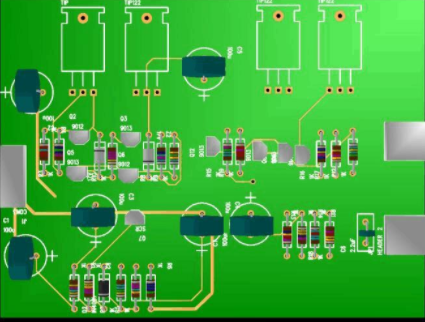The reasons are: the drill bit shifts during the PCB drilling; the cover material is not properly selected, which makes the soft and hard uncomfortable; the base material expands and shrinks to cause the hole position deviation; the used matching positioning tool is used improperly; the presser foot is set when drilling Improperly, hitting the pin to cause the production board to move; resonance occurs during the operation of the drill; the collet is dirty or damaged; the production board, the offset hole of the panel or the entire stack is offset; the drill bit slides when it touches the cover plate; Scratches or creases on the aluminum surface of the cover plate produce deviations when guiding the drill bit down; no pins; different origins; tape is not firmly attached; the X and Y axes of the drilling machine move deviations; there is a problem with the program.
Solution:
(1) A. Check whether the spindle is deflected;
B. Reduce the number of laminates. Usually the number of double-sided laminates is 6 times the diameter of the drill bit and the number of PCB multilayer laminates is 2 to 3 times the diameter of the drill bit;
C, increase the drill speed or decrease the feed rate;
D. Check whether the drill bit meets the process requirements, otherwise re-sharpening;
E. Check whether the drill tip and the drill shank have good concentricity;
F. Check whether the fixed state between the drill bit and the spring chuck is tight;

G, check and correct the stability and stability of the pcb drill table.
(2) Choose a high-density 0.50mm lime cover or replace the composite cover material (the upper and lower two layers are aluminum alloy foil with a thickness of 0.06mm, the middle is a fiber core, and the total thickness is 0.35mm).
(3) According to the characteristics of the board, baking plate treatment is carried out before or after drilling (generally 145 degree Celsius±5 degree Celsius, baking for 4 hours).
(4) Check or check the dimensional accuracy of the tool hole and whether the position of the upper positioning pin is offset.
(5) Check and reset the presser foot height. The normal presser foot height is 0.80mm from the board surface as the best presser foot height for drilling.
(6) Select the appropriate drill speed.
(7) Cleaned or replaced collet chuck.
(8) No pins are installed in the panel, and the pins of the control board are too low or loose, and need to be repositioned and replaced.
(9) Choose a suitable feed rate or a drill with better flexural strength.
(10) Replace the aluminum cover plate with a flat surface without creases.
(11) Nail board work as required.
(12) Record and verify the origin.
(13) Attach the adhesive tape to the edge of the board at a 90o right angle.
(14) Feedback, notify the machine repairer to debug and repair the rig.
(15) Check and verify, and notify the project to make changes.
Common problems and treatments of PCB drilling-large holes, small holes, and hole distortion
The reasons are: wrong specifications of the pcb drill tip; inappropriate feed speed or speed; excessive wear of the drill tip; too many regrinding times of the drill tip or lower than the standard specification; excessive deflection of the spindle itself; tip collapse of the drill tip. The hole diameter of the drilling hole becomes larger; the hole diameter is wrong; the hole diameter is not measured when the drill nozzle is changed; the drill nozzle arrangement is wrong; the position of the drill nozzle is inserted wrongly; the hole diameter diagram is not checked; .
Solution:
(1) Before operation, check the PCB drill bit size and control system for any command errors.
(2) Adjust the feed rate and rotation speed to the most ideal state.
(3) Replace the drill bit and limit the number of holes for each drill bit. Usually 3000 to 3500 holes can be drilled according to double-sided boards (four pieces per stack); 500 holes can be drilled on high-density multilayer boards; 3000 holes can be drilled for FR-4 (three pieces per stack); and for harder ones FR-5, an average reduction of 30%.
(4) Limit the number of drill bit regrinds and the size change of regrind. For drilling multi-layer boards, sharpening once for every 500 holes drilled, 2~3 sharpening is allowed; once for every 1000 holes drilled; once for every 3000 holes drilled for double panels, sharpening once, then drilling 2500 holes; then sharpening Drill 2000 holes at a time. Re-grinding the bit in time can increase the number of bit re-grinding and increase the life of the bit. Measured by a tool microscope, the wear depth within the full length of the two main cutting edges should be less than 0.2mm. When regrinding, 0.25mm should be removed. Fixed shank drills can be reground 3 times; spade-shaped drills can be reground 2 times.
(5) Feed back to the maintenance for a dynamic deflection tester to check the deflection of the spindle during operation. If it is serious, a professional PCB supplier will repair it.
(6) Before drilling, use a 20x mirror to check the knife surface, and sharpen or scrap the bad drill tip.
(7) Check and measure multiple times.
(8) When the drill bit is replaced, the replaced drill nozzle can be measured, and the first hole drilled by the replaced drill nozzle can be measured.
(9) When arranging the drills, count the location of the tool magazine.
(10) Read the serial number clearly when replacing the pcb drill bit.
(11) When preparing the knife, check the actual hole diameter of the hole diagram one by one.
(12) Clean the chuck, and carefully measure and check the condition of the knife surface after pressing the knife.
(13) It is necessary to check repeatedly when inputting the tool number.